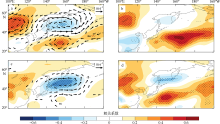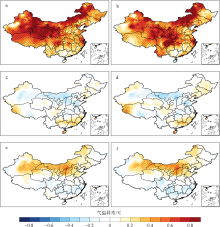Journal of Tropical Oceanography ›› 2021, Vol. 40 ›› Issue (1): 31-43.doi: 10.11978/2020016CSTR: 32234.14.2020016
• Marine Meteorology • Previous Articles Next Articles
Variation of summer marine heatwaves in the Northwest Pacific and associated air-sea interaction
MIAO Yuqing( ), XU Haiming(
), XU Haiming( ), LIU Jiawei
), LIU Jiawei
- Collaborative Innovation Center on Forecast and Evaluation of Meteorological Disasters, Nanjing University of Information Science and Technology, Nanjing 210044, China
-
Received:2020-02-13Revised:2020-03-23Online:2021-01-10Published:2020-04-16 -
Contact:XU Haiming E-mail:20171201089@nuist.edu.cn;hxu@nuist.edu.cn -
Supported by:National Natural Science Foundation of China(41975016)
CLC Number:
- P732.11
Cite this article
MIAO Yuqing, XU Haiming, LIU Jiawei. Variation of summer marine heatwaves in the Northwest Pacific and associated air-sea interaction[J].Journal of Tropical Oceanography, 2021, 40(1): 31-43.
share this article
Add to citation manager EndNote|Reference Manager|ProCite|BibTeX|RefWorks

Fig. 7
Distribution of correlation coefficient between atmospheric circulation field and time series of the first mode of MHWs' days: 500-hPa geopotential height (a), 500-hPa air temperature (b), 850-hPa geopotential height (c), and 850-hPa air temperature (d). Vector indicates anomalous wind (units: m·s-1) field regressed onto the time series. Stippling indicates that correlation coefficient passes the 95% confidence test"


Fig. 8
Distribution of correlation coefficient between atmospheric circulation field and linear trend of the first mode of MHWs' days: 500-hPa geopotential height (a), 500-hPa air temperature (b), 850-hPa geopotential height (c), and 850-hPa air temperature (d). Vector indicates anomalous wind (units: m·s-1) field regressed onto the time series. Stippling indicates that correlation coefficient passes the 95% confidence test 图中矢量表示回归到海洋热浪日数第一模态时间序列线性趋势上的风异常场(单位: m·s-1), 打点区表示通过95%显著性检验的区域。审图号为GS(2016)1561"


Fig. 9
Distribution of correlation coefficient between atmospheric circulation field and inter-annual variability of the first mode of MHWs' days: 500-hPa geopotential height (a), 500-hPa air temperature (b), 850-hPa geopotential height (c), and 850-hPa air temperature (d). Vector indicates anomalous wind (units: m·s-1) field regressed onto the time series. Stippling indicates that correlation coefficient passes the 95% confidence test"


Fig. 10
Distribution of correlation coefficient between atmospheric circulation field and time series of the second mode of MHWs' days: 500-hPa geopotential height (a), 500-hPa air temperature (b), 850-hPa geopotential height (c), and 850-hPa air temperature (d). Vector indicates anomalous wind (units: m·s-1) field regressed onto the time series. Stippling indicates that correlation coefficient passes the 95% confidence test"


Fig. 11
Anomalous summer air temperature(units: °C) field in China regressed onto the linear trend of the first mode (a, b), inter-annual variability of the first mode (c, d), and time series of the second mode (e, f) of MHWs' days. Stippling indicates that the anomalous field passes the 95% confidence test"

| [1] | 李泓, 李丽平, 王盘兴, 2001. 太平洋地区海气系统年代际变率研究的若干进展[J]. 南京气象学院学报, 24(4):591-598. |
| LI HONG, LI LIPING, WANG PANXING, 2001. Advance in study on inter-decadal climate variability of the Pacific atmosphere-ocean system[J]. Journal of Nanjing Institute of Meteorology, 24(4):591-598 (in Chinese with English abstract). | |
| [2] |
叶殿秀, 尹继福, 陈正洪, 等, 2013. 1961—2010年我国夏季高温热浪的时空变化特征[J]. 气候变化研究进展, 9(1):15-20.
doi: 10.3969/j.issn.1673-1719.2013.01.003 |
|
YE DIANXIU, YIN JIFU, CHEN ZHENGHONG, et al, 2013. Spatiotemporal change characteristics of summer heatwaves in China in 1961-2010[J]. Progressus Inquisitiones de Mutatione Climatis, 9(1):15-20 (in Chinese with English abstract).
doi: 10.3969/j.issn.1673-1719.2013.01.003 |
|
| [3] | BANZON V, SMITH T M, CHIN T M, et al, 2016. A long-term record of blended satellite and in situ sea-surface temperature for climate monitoring, modeling and environmental studies[J]. Earth System Science Data, 8(1):165-176. |
| [4] | BOND N A, CRONIN M F, FREELAND H, et al, 2015. Causes and impacts of the 2014 warm anomaly in the NE Pacific[J]. Geophysical Research Letters, 42(9):3414-3420. |
| [5] | CAYAN D R, 1992a. Latent and sensible heat flux anomalies over the northern oceans: driving the sea surface temperature[J]. Journal of Physical Oceanography, 22(8):859-881. |
| [6] | CAYAN D R, 1992b. Latent and sensible heat flux anomalies over the northern oceans: the connection to monthly atmospheric circulation[J]. Journal of Climate, 5(4):354-369. |
| [7] | CHEN KE, GAWARKIEWICZ G G, LENTZ S J, et al, 2014. Diagnosing the warming of the Northeastern U.S. Coastal Ocean in 2012: a linkage between the atmospheric jet stream variability and ocean response[J]. Journal of Geophysical Research: Oceans, 119(1):218-227. |
| [8] | DING TING, YUAN YUAN, ZHANG JIANMING, et al, 2019. 2018: the hottest summer in China and possible causes[J]. Journal of Meteorological Research, 33(4):577-592. |
| [9] |
FENG MING, MCPHADEN M J, XIE SHANGPING, et al, 2013. La Niña forces unprecedented Leeuwin Current warming in 2011[J]. Scientific Reports, 3:1277.
pmid: 23429502 |
| [10] |
FRÖLICHER T L, FISCHER E M, GRUBER N, 2018. Marine heatwaves under global warming[J]. Nature, 560(7718):360-364.
pmid: 30111788 |
| [11] | HOBDAY A J, ALEXANDER L V, PERKINS S E, et al, 2016. A hierarchical approach to defining marine heatwaves[J]. Progress in Oceanography, 141:227-238. |
| [12] | IPCC, 2012. Managing the risks of extreme events and disasters to advance climate change adaptation[R]. London: Cambridge University Press. |
| [13] | KALNAY E, KANAMITSU M, KISTLER R, et al, 1996. The NCEP/NCAR 40-year reanalysis project[J]. Bulletin of the American Meteorological Society, 77(3):437-472. |
| [14] |
KISTLER R, KALNAY E, COLLINS W, et al, 2001. The NCEP-NCAR 50-year reanalysis: monthly means CD-ROM and documentation[J]. Bulletin of the American Meteorological Society, 82(2):247-268.
doi: 10.1175/1520-0477(2001)082<0247:TNNYRM>2.3.CO;2 |
| [15] |
LI GEN, REN BAOHUA, YANG CHENGYUN, et al, 2011a. Revisiting the trend of the tropical and subtropical Pacific surface latent heat flux during 1977-2006[J]. Journal of Geophysical Research: Atmospheres, 116(D10):D10115.
doi: 10.1029/2010JD015444 |
| [16] |
LI GEN, REN BAOHUA, ZHENG JIANQIU, et al, 2011b. Trend singular value decomposition analysis and its application to the global ocean surface latent heat flux and SST anomalies[J]. Journal of Climate, 24(12):2931-2948.
doi: 10.1175/2010JCLI3743.1 |
| [17] |
NORTH G R, BELL T L, CAHALAN R F, et al, 1982. Sampling errors in the estimation of empirical orthogonal functions[J]. Monthly Weather Review, 110(7):699-706.
doi: 10.1175/1520-0493(1982)110<0699:SEITEO>2.0.CO;2 |
| [18] |
OLITA A, SORGENTE R, NATALE S, et al, 2007. Effects of the 2003 European heatwave on the Central Mediterranean Sea: surface fluxes and the dynamical response[J]. Ocean Science, 3(2):273-289.
doi: 10.5194/os-3-273-2007 |
| [19] |
OLIVER E C J, DONAT M G, BURROWS M T, et al, 2018a. Longer and more frequent marine heatwaves over the past century[J]. Nature Communications, 9(1):1324.
doi: 10.1038/s41467-018-03732-9 pmid: 29636482 |
| [20] |
OLIVER E C J, LAGO V, HOBDAY A J, et al, 2018b. Marine heatwaves off eastern Tasmania: trends, interannual variability, and predictability[J]. Progress in Oceanography, 161:116-130.
doi: 10.1016/j.pocean.2018.02.007 |
| [21] |
OLIVER E C J, 2019. Mean warming not variability drives marine heatwave trends[J]. Climate Dynamics, 53(3-4):1653-1659.
doi: 10.1007/s00382-019-04707-2 |
| [22] | PEARCE A, LENANTON R, JACKSON G, et al, 2011. The “marine heat wave” off Western Australia during the summer of 2010/11[R]. Fisheries Research Report No. 222. |
| [23] | PEARCE A F, FENG MING, 2013. The rise and fall of the “marine heat wave” off Western Australia during the summer of 2010/2011[J]. Journal of Marine Systems, 111- 112:139-156. |
| [24] | QIN HUILING, KAWAMURA H, KAWAI Y, 2007. Detection of hot event in the equatorial Indo-Pacific warm pool using advanced satellite sea surface temperature, solar radiation, and wind speed[J]. Journal of Geophysical Research: Oceans, 112(C7):C07015. |
| [25] | QIN HUILING, KAWAMURA H, 2010. Air‐sea interaction throughout the troposphere over a very high sea surface temperature phenomenon[J]. Geophysical Research Letters, 37(1):L041685. |
| [26] |
REYNOLDS R W, SMITH T M, LIU CHUNYING, et al, 2007. Daily high-resolution-blended analyses for sea surface temperature[J]. Journal of Climate, 20(22):5473-5496.
doi: 10.1175/2007JCLI1824.1 |
| [27] |
SCANNELL H A, PERSHING A J, ALEXANDER M A, et al, 2016. Frequency of marine heatwaves in the North Atlantic and North Pacific since 1950[J]. Geophysical Research Letters, 43(5):2069-2076.
doi: 10.1002/2015GL067308 |
| [28] |
WALISER D E, 1996. Formation and limiting mechanisms for very high sea surface temperature: linking the dynamics and the thermodynamics[J]. Journal of Climate, 9(1):161-188.
doi: 10.1175/1520-0442(1996)009<0161:FALMFV>2.0.CO;2 |
| [1] | YUAN Yu, XU Haiming, MA Jing, ZHANG Tong. Impact of Atlantic Multidecadal Oscillation on interannual relationship between ENSO and early summer marine heatwaves in the Western Pacific* [J]. Journal of Tropical Oceanography, 2024, 43(5): 1-16. |
| [2] | Yuanyuan FU, Xuhua CHENG, Yuhong ZHANG, Youfang YAN, Yan DU. The freshening trend of surface salinity in the South China Sea in recent two decades and its mechanism [J]. Journal of Tropical Oceanography, 2017, 36(4): 18-24. |
| [3] | Yanping SHI, Yan DU, Zesheng CHEN. Impacts of Northwest Pacific anomalous anticyclone on sea surface height and circulation [J]. Journal of Tropical Oceanography, 2017, 36(4): 10-17. |
| [4] | SUN Zhiquan, XIANG Jie, GUAN Yuping. Strengthening of the Pacific Walker Circulation in the recent decades [J]. Journal of Tropical Oceanography, 2016, 35(2): 19-29. |
| [5] | DU Mei-fang, XU Hai-ming, ZHOU Chao. Analysis of non-uniform sea surface temperature warming over the tropical oceans and its causes based on CMIP5 data [J]. Journal of Tropical Oceanography, 2015, 34(3): 1-12. |
| [6] | ZHU Xue-ming, SONG De-hai, BAO Xian-wen, LIU Gui-mei. Tidal energy flux and dissipation in the Northwest Pacific [J]. Journal of Tropical Oceanography, 2014, 33(1): 1-9. |
| [7] | WANG Jie, DUAN Zi-qiang, YAO Xiao-hong, GAO Hui-wang. Correction of ship-based turbulent wind velocity and characterization of turbulence in the Northwest Pacific [J]. Journal of Tropical Oceanography, 2013, 32(3): 9-15. |
| [8] | SHEN Qi, ZHU Jian-rong, DUAN Yi-hong, SUN Ming-hua. Numerical simulation of ocean circulation and temperature in the Northwest Pacific using a vertical S-coordinate model [J]. Journal of Tropical Oceanography, 2012, 31(6): 20-28. |
| [9] | TENG Wei-cheng, GUAN Lei. Diurnal variation correction of AVHRR SST data for the Northwest Pacific region [J]. Journal of Tropical Oceanography, 2012, 31(4): 1-7. |
|
||













